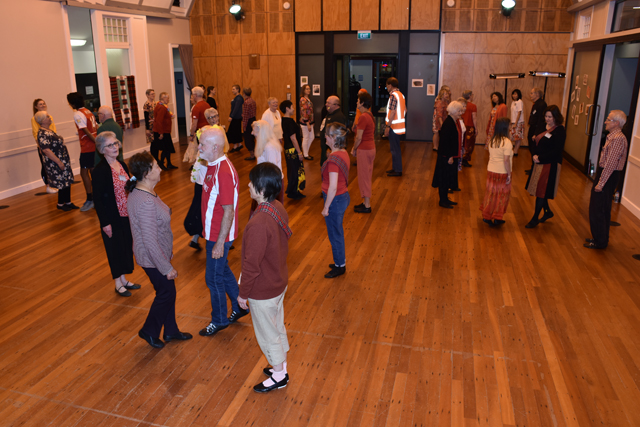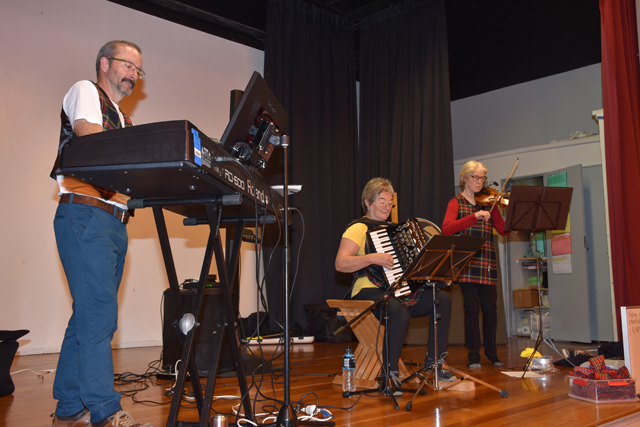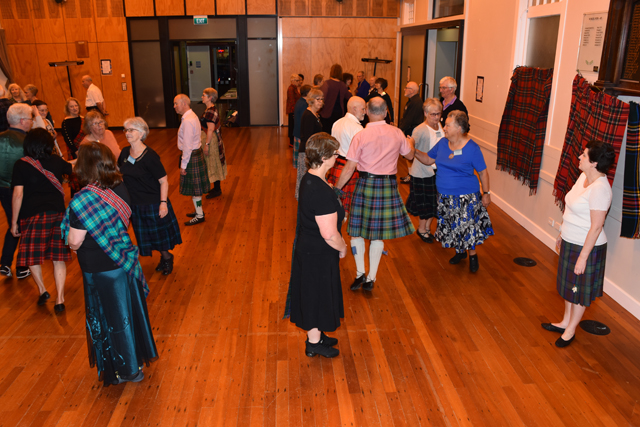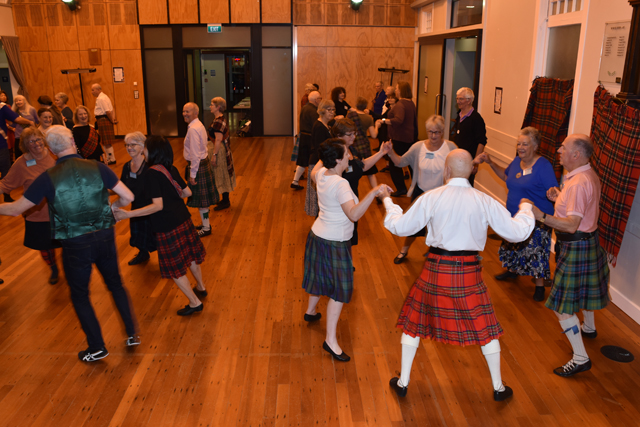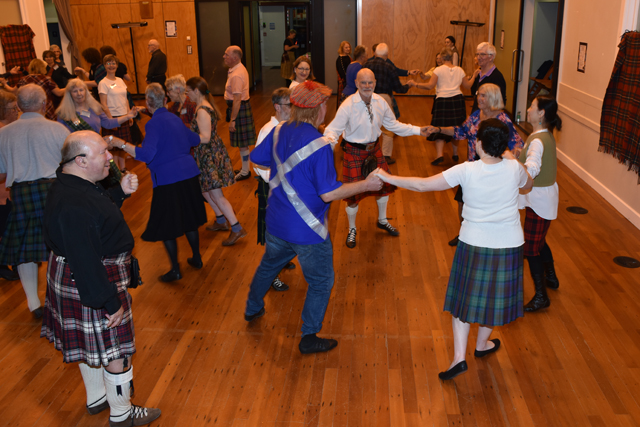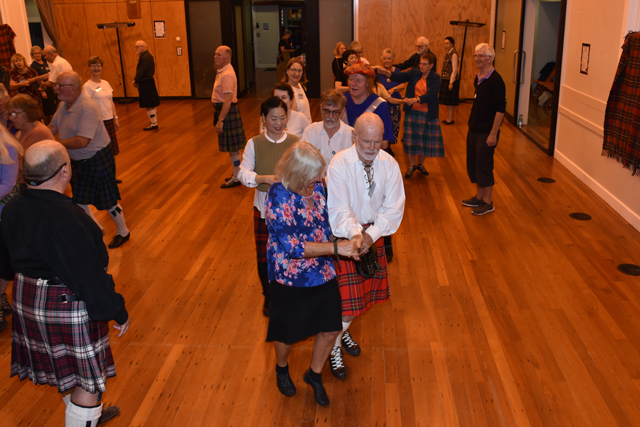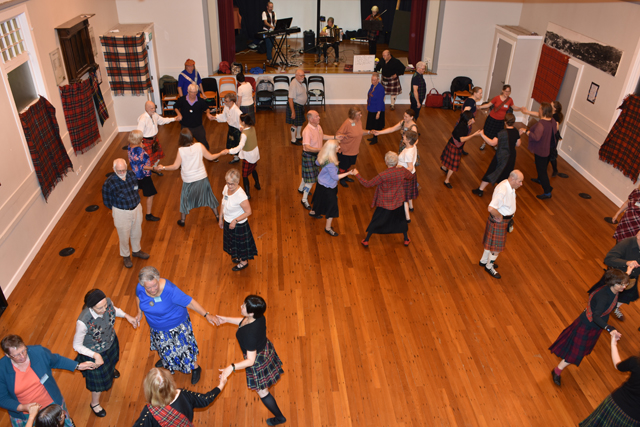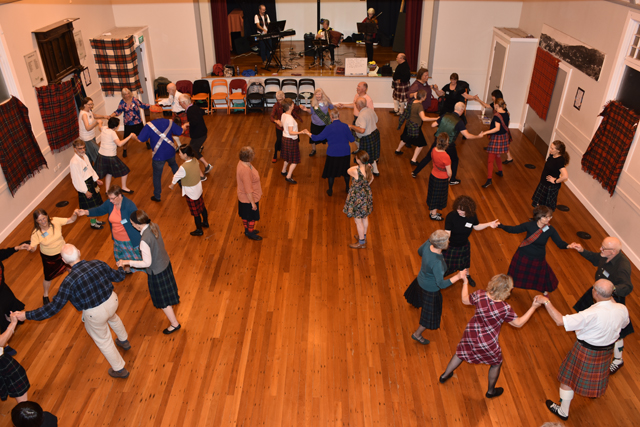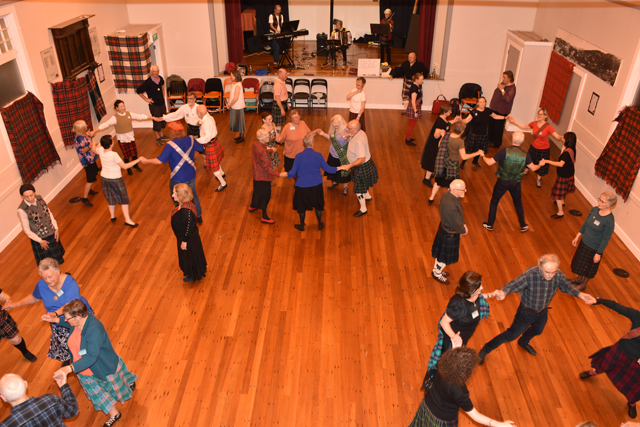text to come
Author Archives: Loralee Hyde
Loralee Hyde: An Afternoon of Historical RSCDS Dances
A special celebration of our Dance Scottish history
Following the very successful Early Wellington Dances afternoon in 2023 to celebrate the RSCDS Centenary, the Wellington Region organised a special afternoon of Historical RSCDS Dances for intermediate dancers and above on Saturday 27 April 2024.
Close on 40 dancers from around the Region and Manawatū along with two visitors from Canberra, gathered in the St John’s Anglican Church Hall in Johnsonville, eager to try out dances not commonly done nowadays.
Wellington Region President and Johnsonville tutor Rod Downey selected and taught the dances. To add to this special afternoon, Lynne Scott and Sam Berkahn provided the music. We also welcomed Edith Campbell who had suggested having this afternoon of older dances.

Source of the dances: RSCDS Books 1-5
RSCDS Book 1 was first published in 1924, meaning 2024 was the Centenary of this publication, the first of the numbered RSCDS Book series. Rod chose dances from RSCDS Books 1-5, all pre-1930.
These books contain 60 dances. Rod selected dances for the afternoon based on interest and danceability. He avoided dances that are relatively well-known, for example, Glasgow Highlanders.
He tried to feature a variety of formations, which is not an easy task when using the early books. For example, seven of the 12 dances of Book 1 finish with a poussette. Rod kindly did not wish to tire our legs out during the afternoon with an overabundance of Pas-de-basque so took care with his selection of dances. He included at least one dance from each of Books 1-5.
The music: A fun challenge to arrange the sets of tunes
Lynne says it was a fun challenge to put together sets of music for the early dances. To add an authentic feel of dancing during the times the dances were devised, over half the tunes she and Sam played during the afternoon were composed by famous fiddler/composers of the 18th century:
- Niel Gow (b 1727)
- Nathaniel Gow (his son, b 1763)
- William Gow (another son b c.1750)
- Robert Mackintosh (b 1750)
- John RIddell (b 1728)
- Alexander Gibb (b in 1700’s)
- Malcolm MacDonald (b c.1740)
- William Marshall (b 1748)
- James MacDonald (b 1700’s)
Lynne adds the tunes were written and being danced to well before the invention of the accordion. A typical dance band of the time would have been fiddle (and/or perhaps flute/recorder) with cello.
To give us a taste of an authentic experience, Lynne played the fiddle while Sam played the cello for three dances (two reels and a strathspey) and keyboard for the others.

The remainder of the tunes played were ‘traditional’ but also mostly from the 18th and 19th centuries.
The dances: Somewhat vigorous with unusual formations
Rod welcomed us to the afternoon, saying dances from Books 1-5 are ‘quite vigorous’, with some ‘tricky formations’. This proved to be so!
We started the afternoon with the jig Light and Airy Book 4, devised by William Campbell in 1790; a dance familiar to a number of us. Rod encouraged us to be ‘light or airy’ in our dancing to make the most of the music.
Then to The Triumph Book1, a reel Introduced by Nathaniel Gow in 1808. The unusual feature of this dance is a poussette for one couple, which required some practice under careful tutelage from Rod.

We tried Lady Macintosh’s Rant next (also known as The Duke is Welcome to Inverness), a strathspey by Rutherford 1754 from Book 3. Rod shared he’d taught this dance at Johnsonville Club the previous week and discovered it had a bunch of hooks for both the tutor and dancers!
A tricky dance indeed, with the first couple starting on opposite sides and only returning to own sides when they reach the foot of the set. Some discombobulation was apparent during the dancing (you may spot a few perplexed faces in the photos).

Rory O’More, a jig from Book 1 ‘collected locally’, was rather entertaining. In Rod’s old version of Book 1, the instructions indicate that after the first couple dances down the middle, for Bars 21-24 the first couple dance back up the middle backwards! This did feel slightly weird but I could imagine the ladies of the 18th Century, dressed in their long full gowns (with perhaps bustles), finding it easier to ‘retire’ rather than turning around in the middle of the set before dancing back to the top.
Haughs o’ Cromdale Book 4, a 16 bar strathspey from the 18th Century ‘collected in Galloway’ also had some interesting quirks, with a version of the Diamond Poussette danced using Highland Schottische which stretched our brains.
Lynne says an interesting link with New Zealand arose when she was researching Joseph Lowe (b 1796) who wrote the second tune played for this dance. Joseph was a dance teacher for the Royal Family at Balmoral and Windsor. One of his sons emigrated to New Zealand and taught dance here. His family continued the dance tradition, with one of the grandsons being Sir Jon Trimmer, the renowned ballet dancer.
A break for our brains and bodies was needed after the complex array of dances we’d tried out during the first half of the afternoon. Thanks so much to Elaine and Kevin Lethbridge for preparing and bringing along a sumptuous afternoon tea for all of us to enjoy (including gluten free and dairy free options for those with restrictive diets).
Fortified with great food and a cuppa, we set forth to find out more about The Princess Royal Book 2, a 28 bar reel collected around 1850. This is the only 28 bar RSCDS dance Rod knows of. Lynne says it was a particular challenge to put together the set of music for this 28 bar dance! Although it had Pas-de-basque in the Half Petronella, I thought the tempo of the dance was perfect and the dance didn’t overly tax my legs.
The Haymakers, a 48 bar jig in Book 2 from around 1761 or earlier, contains running step which was popular in some of the old dances, such as this one and Strip the Willow. We are probably more likely to come across this dance at a ceilidh nowadays than at a Scottish Country Dance.

Zooming around the floor using running step in The Haymakers
The Duke of Hamilton’s Reel, a strathspey from 1754 in Book 5, has an intricate start as the first man turns the second woman right hand one and a half times at the same time as the first woman and second man turn. Once we mastered that, we realised an aide-mémoire was sometimes needed for the second couple, as on bars 9-10 they needed to move down and then move back up on bars 13-14.
We danced this strathspey to some wonderful tunes. Lynne says the tunes she and Sam played were The Bob o’Dowally (published c.1760), The Red Plaid (unknown), Lady Gwyder (Bowie) and The Laird o’ Macintosh (published early 1800s). A fabulous set of tunes!
Rod chose to finish the afternoon with The Merry Dancers Book 4, a jig from1827. Quite a vigorous dance with some strong turns needed plus setting to and turning corners. And finally Dumbarton Drums Book 5. A reel from 1816 danced to uplifting traditional tunes.
Thanks so much to Rod for all the work he put into researching dances from so back in our Scottish Country Dancing history and selecting and teaching the dances in his thought-provoking, balanced programme.
Thanks also to our musicians Lynne and Sam for all the research into authentic music, arranging the lovely sets of tunes and playing for us all afternoon. It’s marvellous to have such outstanding live music available in Wellington to enhance the joy of the dance.
And thanks to the dancers who came along to try the host of unfamiliar dances and help each other through the unusual formations, and to all others who helped make this afternoon of historical RSCDS dances such a memorable occasion.
See more about the history of the dances, music and formations in Rod’s notes
Click here to see the smiles in all of Loralee’s photos and download if you wish

Loralee Hyde
4 May 2024

Obituary: Jean Denne
Former Johnsonville Club member Jean Denne passed away on 9 April 2024 at the age of 83.
She was a club member from 2004-2015, joining the same year as Prisilla and a year after Elizabeth Ngan.
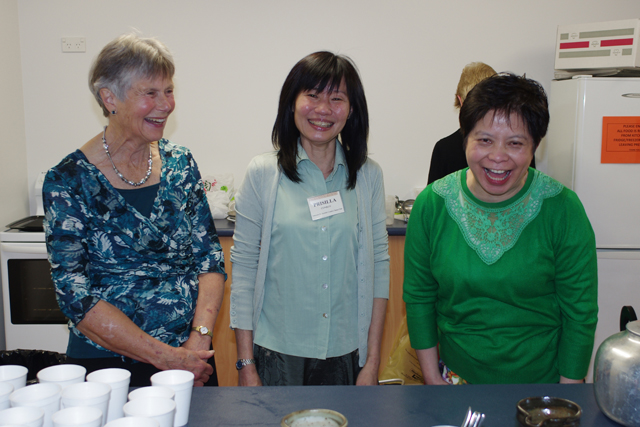
Jean was a keen dancer, enjoying tartan nights, annual dances, summer ceilidhs and mid-winter dinners.
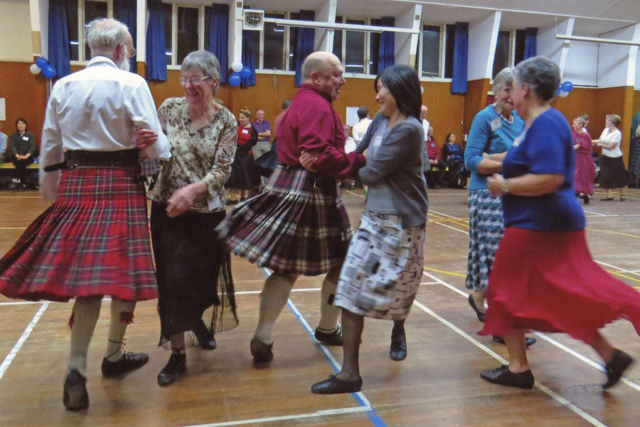

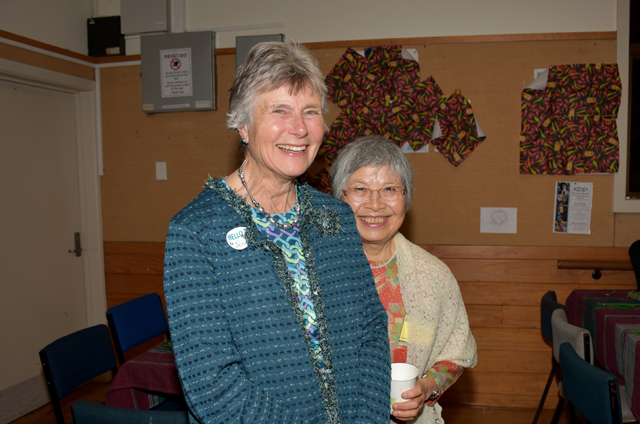


Jean also gave a great deal to the club, serving as a committee member, and on the supper team for many years alongside both Elizabeth and Prisilla.
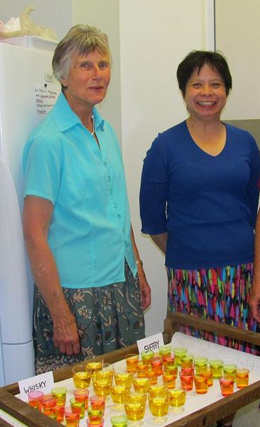
Jean could always be relied upon to do whatever was needed that others might not think to do (like cleaning the bathrooms in preparation for the annual dance).

We have missed her smiling face and willing work at club in the years since she stopped dancing.
Jean was farewelled by family in a private service.
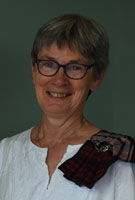
Kristin Downey
18 April 2024
Historical photos compiled by Loralee Hyde
April Tartan Night 2024: A great success with smiling faces
Johnsonville’s first Tartan Night of 2024 on 15 April was a great success. No need for more than a brief report, as the smiling faces in Loralee’s photos say it all:
- A great programme from our tutor and MC Rod
- Wonderful music from the band—Aileen Logie, Hilary Ferral and Jason Morris
- A great turnout of members and visitors, six sets in all
- Colourful tartan all around us—on the dance floor and the walls
- A spirit of bonhomie and good will, with experienced dancers supporting newer members
- A fine supper supplied by members, and served by our dedicated supper team.
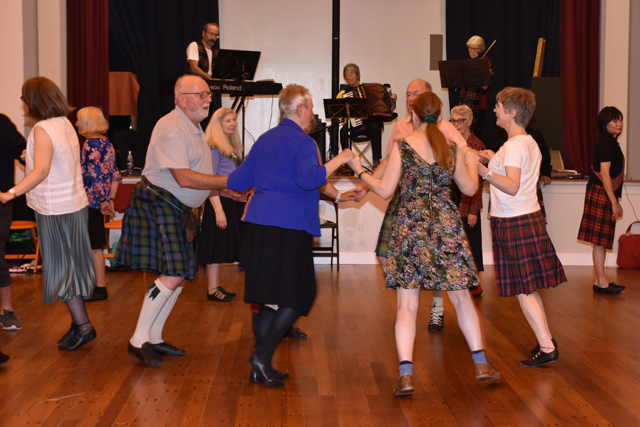
This first Tartan Night of the year is such a nice way of introducing new dancers to the fun of a social night dancing to a full band. It was fantastic to see six of Johnsonville’s beginners having a great time on this special night, as well as one total beginner and a beginner from Capital City.
To me, tartan colours and the swirl of kilts and sashes on the dance floor add hugely to the atmosphere, and I really appreciate the effort put in by club members to dress in tartan, whether it be trad or a bit of fun.
For Christine and Maura, it was the first outing for kilt skirts from the club’s second-hand collection. Trinity and Jason wore their Malcolm family tartans—Trinity in her grandmother’s kilt skirt and Jason in his wedding vest.
Then there was Catherine in her plaid culotte-shorts, and Colin wearing a Tam O’Shanter and an ingenious St Andrew’s cross of carpet tape on his blue t-shirt.
Thanks to Rod, the band, members and visitors, the supper team and all those who helped with setup and packup. It was a great night, and we can look forward to having just as good a time at our next Tartan Night at club on Monday 17 June.
Enjoy Loralee’s photos of the night showing all the smiles on the dance floor in the gallery below.

Kristin Downey
17 April 2024
Download the April 2024 Tartan Night Programme

Loralee Hyde: My memories of Bronwyn Maysmor
I was saddened to learn of Bronwyn Maysmor’s death on 19 January 2024 at the age of 77 years. Following my move to Lower Hutt from Hamilton in 1983, I joined Lower Hutt Scottish Country Dance Club where I met Bronwyn who lived in Eastbourne at that time. She quickly involved me in social activities with other club members.
My abiding memory of Bronwyn is her love of colour—in gardens, her clothes and her dancing shoes (usually a shade of blue or mauve).
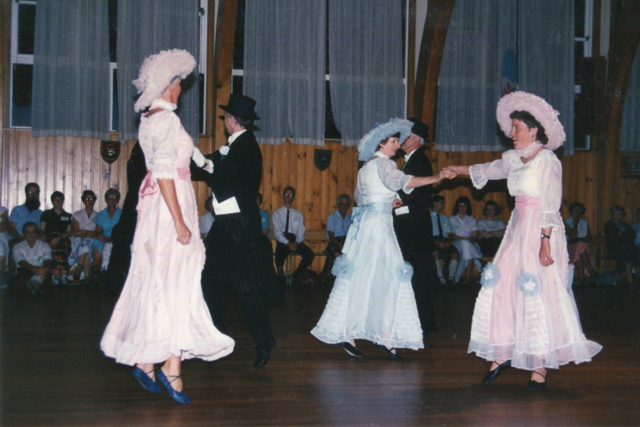
Bronwyn (together with Ian) took part in many Scottish Country Dancing events in the Wellington Region including Balls, Hogmanays and New Dancers’ Celebrations. Often, she dressed in fabulous costumes to fit the theme of the event.
Like Bronwyn, I love colour, including shades of blue and purple. I enjoyed visiting various gardens with her to admire the colourful flowers in bloom.

Bronwyn contributed many articles to Harbour City Happenings about activities at her club and produced a Tribute (with Charlotte Williams) to Norman Whitson, a long-term tutor at Eastbourne Club, and one to Betty Redfearn.
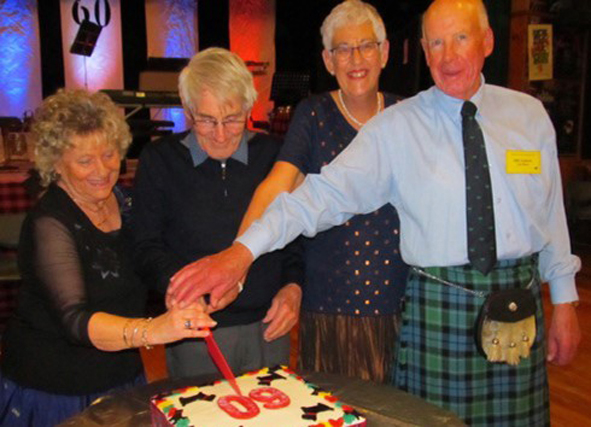
Three events I enjoyed with Bronwyn stand out in my memory.
The first was a trip to Morison’s Bush in the Wairarapa in 1992 for the weekend of the Martinborough Fair with a number of dancers including Bronwyn and Ian, Elizabeth and Malcolm Ferguson, Iain Boyd, Noeline O’Connor, Kath Burn, Betty Redfearn, Val Jenness, Margaret Hepworth and Beth Duncan.
We appreciated Morison’s Bush for the history of Scottish Country Dancing in New Zealand—for many years, the area was the centre of social life and dances for dancers in Wellington, Wairarapa, and Hawke’s Bay. Morison’s Bush was also the site of the first Scottish Country Dance Ball in New Zealand.
We stayed in a beautiful old homestead at Morison’s Bush near the Ruamāhanga River with the evenings chatting. laughing and barbecuing dinner.

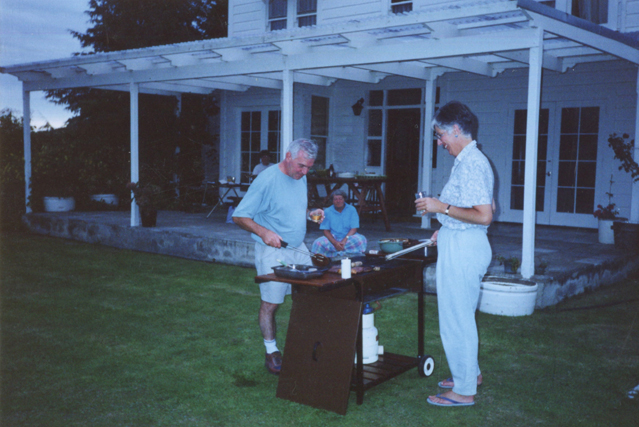
Early on the Saturday morning we set off for the Martinborough Fair to make sure we got a nearby park. Activities back at the homestead in the afternoon included volleyball, board games or walking along the river.
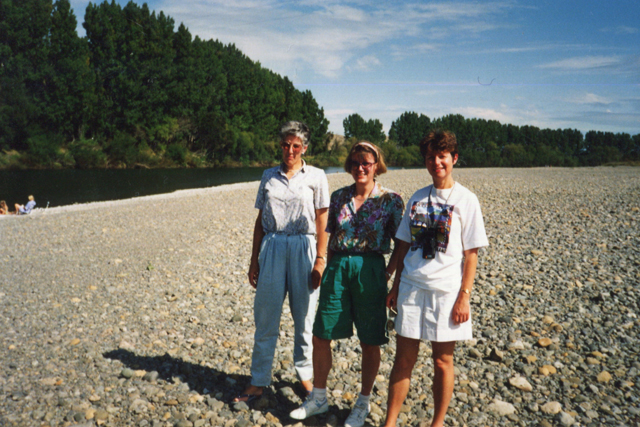
I had the opportunity to see Bronwyn’s superb organisation skills in action when I was on the committee for the Wellington Region Event in 1993, with Bronwyn as organiser.
The Region decided to celebrate the 25th anniversary of the New Zealand Branch in 1993 with a dinner and ceilidh (called the Top Event) in February before the dancing season started.
Alan Burn, the Region President at the time, suggested honouring Wellington Region teachers at the event for their dedicated work. The Region sponsored teachers to attend; although clubs did have the opportunity to sponsor their own tutor if they wished.
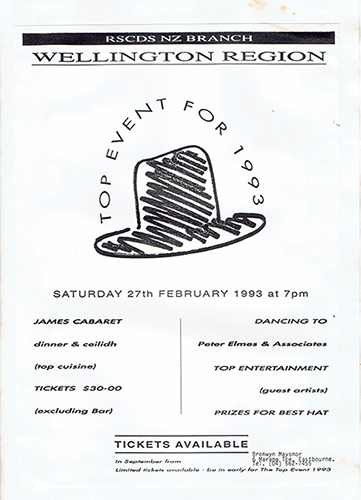
The event committee asked those attending to wear a hat of any description to the Top Event held on 27 February 1993 at the James Cabaret (now closed) in Wellington. The evening started with a happy half hour of socialising, mixing and talking about each other’s hats.
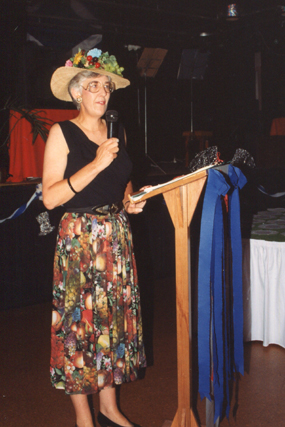
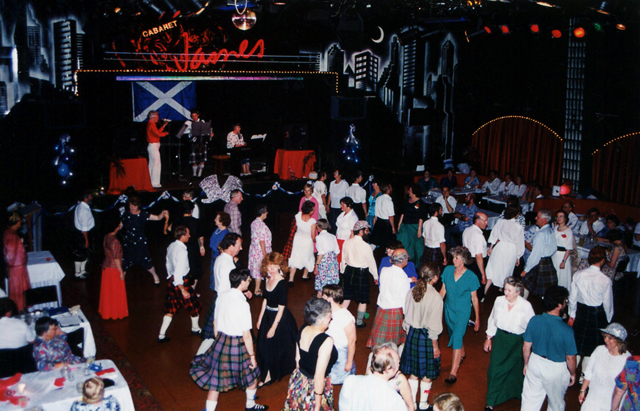
We welcomed 26 Wellington tutors to the event. The photo below is a great historical record of Scottish Country Dancing in the Region at that time. The teachers in the photo are:
Back row: Iain Boyd, Margaret Laidlaw, Romaine Butterfield, Rita Brennan, Margaret Allison (Bailey), Edith Campbell, Hilda Brodie (Smith), Kath Burn, Maureen Robson, Damon Collin, Dave Macfarlane, Mirth Smallwood, Barbara Gill, Elizabeth Ferguson, Val Jenness, Gary Morris, Marie Malcolm, Alma Secker, Glenys Mills, Noeline O’Connor, Ian Simmonds, Raynor Stratford.
Front row: Betty Redfearn, Norm Whitson, Carol Smith, Annette Zuppicich
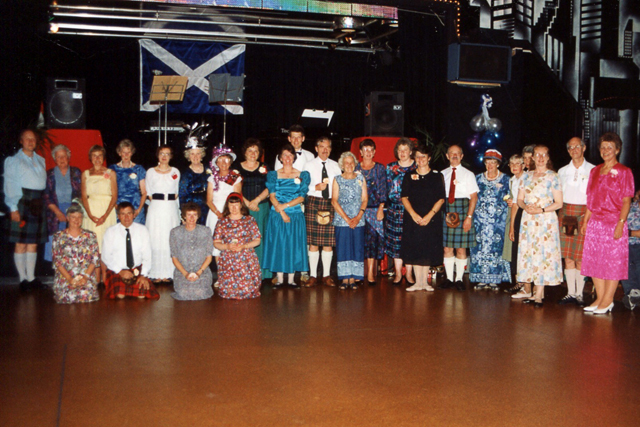
See more about the Top Event including the wide variety of items performed by dancers from the Region in this article in the 1993 New Zealand Scottish Country Dancer
The third event I well remember is Bronwyn and Ian’s wedding in February 1994 at the Dowse Art Museum in Lower Hutt, followed by a ‘dessert party’. We were each asked to bring a dessert—a simple and enjoyable way of celebrating. There were plenty of ‘oohs and ahhs’ from people as they chose from the wide array of desserts on offer.
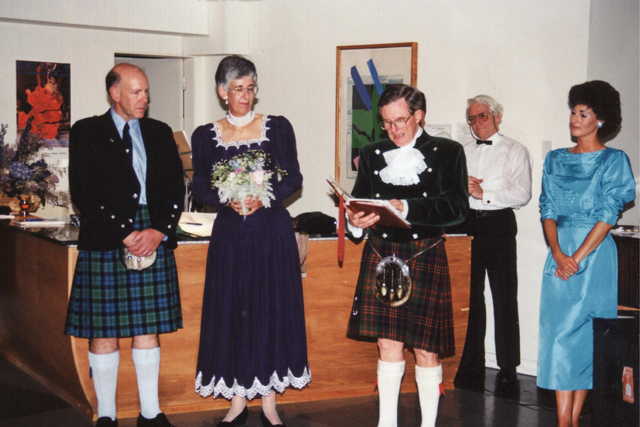
I have enjoyed looking through my albums to find photos of Bronwyn and Ian at events from 1990 onwards. (Prior to that, the quality of my camera wasn’t good enough to take photos of actual dancing).
The last photograph I have of Bronwyn was at the 2019 Wellington Region Hogmanay at Crofton Downs Primary School hall organised by Johnsonville Club.
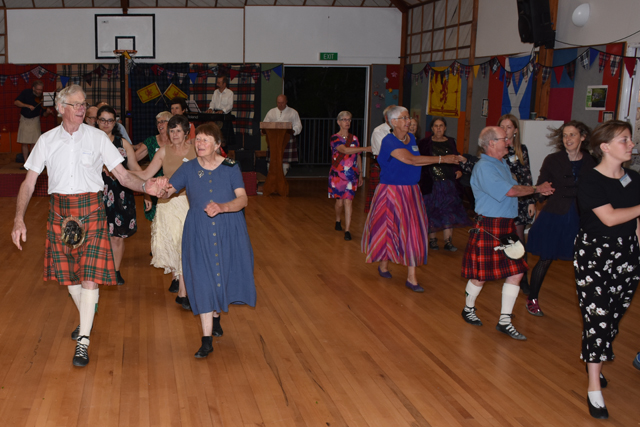
A few months later, the pandemic hit. Sadly, I didn’t have the chance to catch up with Bronwyn again. I will miss seeing her dance in her beautiful mauve shoes.
See more of Loralee’s photos and download if you wish

Loralee Hyde
4 March 2024
All photos by Loralee Hyde except where noted
New Zealand Summer Schools: The fun of it all!
In 2019, Johnsonville Club member Désirée Patterson gave this great account of New Zealand Branch Summer Schools she had attended, including what is involved during this week of Scottish Country Dancing; the classes, social activities and evening events as well as the fun and friendship.
Last year, I had a wonderful week at the Tāmaki Makaurau Auckland 2022-2023 Summer School, the first get-together for three years due to the pandemic. My highlights included taking part in an innovative Excursions Group during the mornings, designed for non-dancers and those like me who wanted to save their legs for the evening functions.
Katharine Hoskyn from Auckland organised the excursions for the group. She sent us a survey to complete beforehand, asking what we would like to do and see on the excursions—ranging from walks in gardens to visiting the Art Gallery and Museum to having coffee breaks. Going to a café every morning was top of the picks! That’s always an opportunity for more chatting and laughter.

The excursions gave us a chance to get to know people from other parts of New Zealand and Australia. Being awed by the sheer size of two Tyrannosaurus skeletons at the Auckland Museum was just one of our fun-filled activities (yes, we also had coffee at the Museum).

See all my highlights and photos of the Auckland Summer School
For Summer School 2023-2024, it was the turn of the RSCDS New Zealand Branch Nelson/Marlborough Region to host us in Nelson—billed as the place for dancing, sun and friendship!
Catching-up with old friends from around New Zealand and the world (together with making new friends) is one of the highlights of Summer School. On the first night of dancing, the laughter and chatter echoed around the hall.
I wondered what fun we would have during the rest of the Summer School at classes, evening functions and other social activities.
A good number of dancers represented the Wellington Region at Nelson. Plus, Ann Oliver taught the Social Class, Catherine McCutcheon took Advanced and Lynne Scott led the Musicians’ Class. Aileen Logie, Jason Morris, Hilary Ferral and Ian Telfar played in the band. And Elaine Laidlaw briefed Hogmanay.
A Hogwarts themed fancy dress night set the scene for many amazing costumes along with dances fitting the theme and lots of smiles and laughter. I managed to concoct a Hedwig the owl costume entirely from bits and pieces I found at home, with a mask template downloaded from the web.
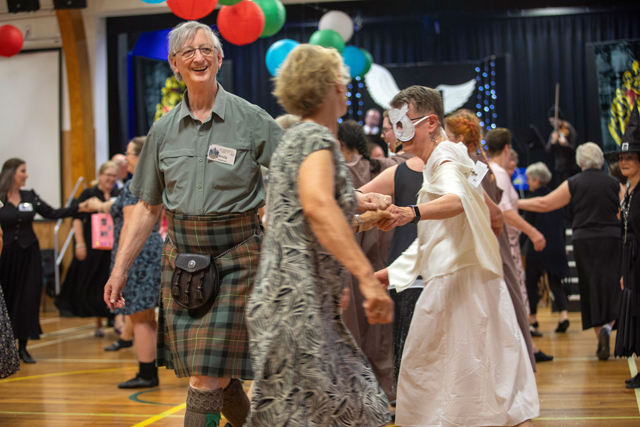
Remarkably. I danced Slytherin House partnered by Fluffy, the three-headed dog (with three dancers dancing as one!). The rest of the set was very accommodating, particularly while dancing the Snake Pass.
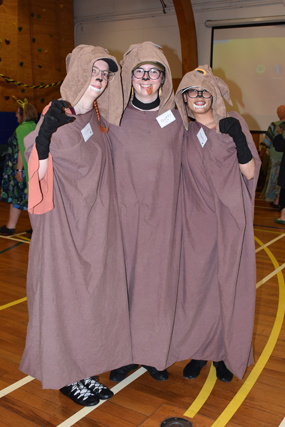
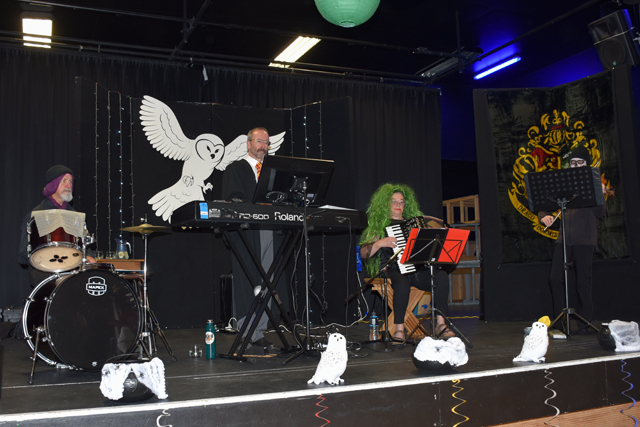
At Hogmanay on New Year’s Eve it was a delight to see Feshiebridge danced. Devised by long-time Wellington Region tutor Gary Morris, this was one of the dances we enjoyed at the special afternoon of Early Wellington Dances held in April 2023 to celebrate the Centenary of the RSCDS.
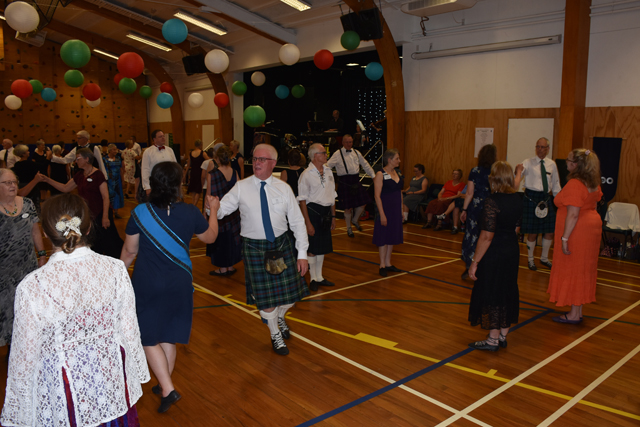
Although morning classes cover the serious business of step practice, learning new formations and dancing together as a team, there are plenty of fun-filled moments. I enjoyed three mornings dancing with the Social Class where there was an intense focus on learning as much as possible about the intricacies of dancing and the music.

Ann wrote the dances of each day on a board as an aide-mémoire for us. Lo and behold … there were fine artists amongst us who drew cartoons representing each dance on the board! Resulting in lots of laughter and discussion as well as providing visual clues to help us remember the dances.
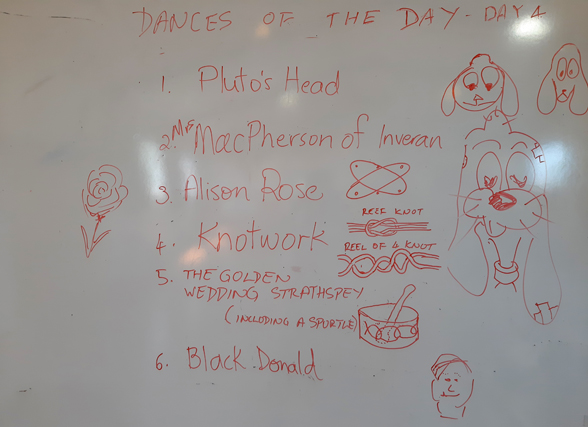
Black Donald is a Highland colloquialism for the Devil in Scottish mythology. The defining characteristic of Black Donald is his cloven feet, which betray whatever disguise he assumes. Some may consider the cartoon of Black Donald on the board above, more closely resembles a certain Donald involved in politics in the USA.
Summer School often has afternoon excursions for dancers. One afternoon, we went to Mapua, a lovely village on the coast, where we walked along the wharf in the fresh sea air or had a coffee (of course!). We then could choose between going to Neudorf Vineyards for wine tasting or to Rabbit Island for a stroll along the beach.
My joy of dancing is equalled by my love of our native bush and wildlife. On another afternoon, a group of us went to the Brook Waimārama Sanctuary, a 690-hectare fenced haven for our unique biodiversity.
How relaxing it was to stroll along the tracks through the bush and along the Brook Stream in the fresh air; recuperation for our brains which had worked so hard at classes and evening functions, and for our sore legs. Thanks to Janet from the Summer School Committee who organised this special visit for us (she’s a volunteer at the sanctuary).
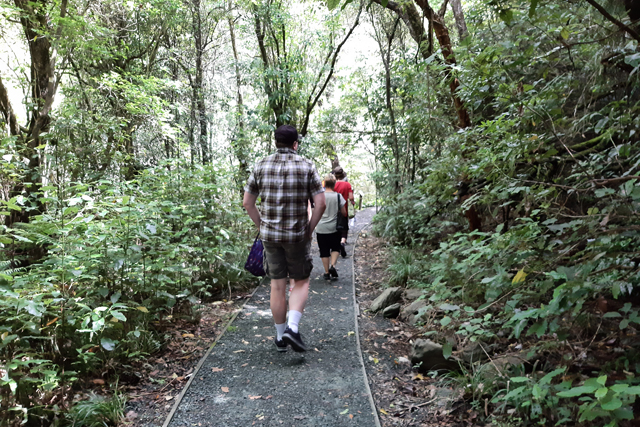
Summer School ceilidhs are full of clever, entertaining items ranging from performances from musicians to recitations to singing, along with (sometimes quite wild) dancing! Superbly organised and MC’d by Ruth Budden from Tuakau, the Nelson ceilidh was no different.
Ruth was also the tutor of the Teacher Training Class, but somehow she found the time to teach some other Scottish Country Dancers some Rock and Roll moves. Well done all!
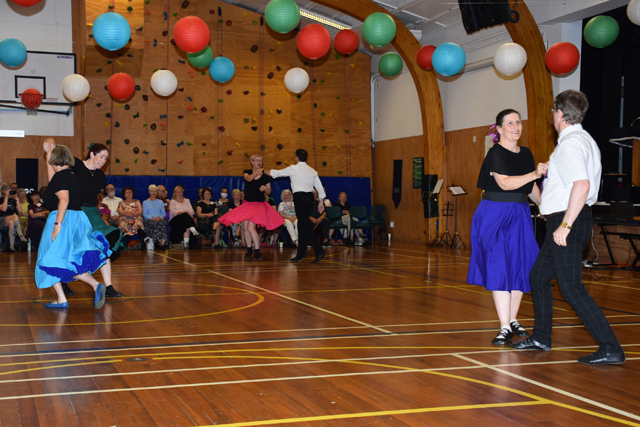
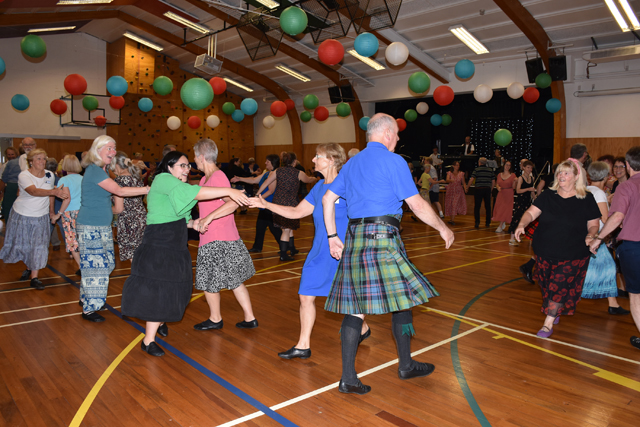
At the ceilidh, a group of Wellingtonians including the 2024-2025 Summer School Organiser Ann Oliver and members of the Committee, danced Catch the Wind devised by Romaine Butterfield to welcome everyone to the next Summer School in Wellington.
This dance ties-in with the catch-cry of the School—You’ll be blown away by a Wellington welcome! To great acclaim from the crowd, the team tried out a number of variations of the dance; all carefully planned of course, and within the spirit of having fun!
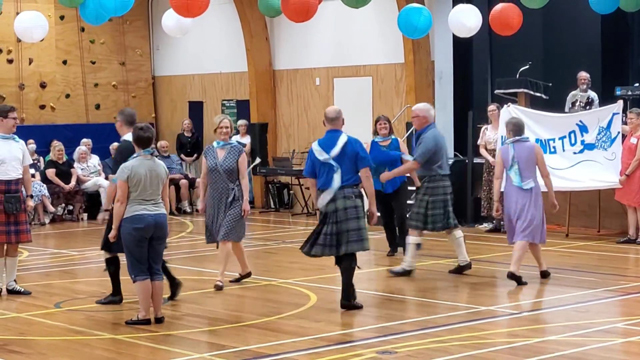
In a nod to the ‘windy’ theme of the next Summer School in Wellington, the last dance on the Final Night was The Wind That Shakes the Barley. Watch this video from the RSCDS New Zealand Branch to see the joy of the dance. Hear the fabulous music from the band alongside musicians from the Summer School Musicians’ Class led by Lynne Scott! And hear the whoops of joy at the end!
Thanks so much to Doug Mills and Lynda Aitchison and their committee for organising this Summer School in sunny Nelson, and thanks to the tutors, musicians, MCs, gophers, makers of morning teas, drivers, photographers, videographers and others who helped make this such a successful get-together.
I’ve lost count of the number of New Zealand Summer Schools I’ve attended; but all had lots of fun and friendship. I do recommend coming along to the 2024-2025 Wellington Summer School, especially as there’s a commuter option for those who live nearby.
Find out more and register online There’s fun to be had!
See all my photos of Nelson Summer School and download if you wish
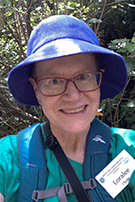
Loralee Hyde
29 February 2024
All photos by Loralee Hyde except where noted
Summer Ceilidh 2024: A relaxed and convivial affair
In the end, we had almost perfect weather for this year’s summer ceilidh at Johnsonville Bowling Club on Saturday 27 January. The morning rain cleared, leaving us with sunny skies and the club house at a much more danceable temperature than it otherwise would have been.
Twenty-three members and three guests registered, with a bonus guest on the day, when Kathryn and David ended up on grandparent duty. It was great to welcome seven first-timers amongst the crowd, six of whom were new club members in 2023.
Bowling and chatting
The only side-effect of the morning rain was a delay to the bowling club champs, the closure of one of the greens, and a little bit of a wait for rinks to free up on the green for us.
Our bowlers took it in their stride, distracting themselves with socialising, then organising their own bowls, and getting themselves started with agreed rules (if not necessarily as per the rule book).
Once they got going, they were reluctant to leave the green, and almost missed out on the great selection of nibbles before dancing!
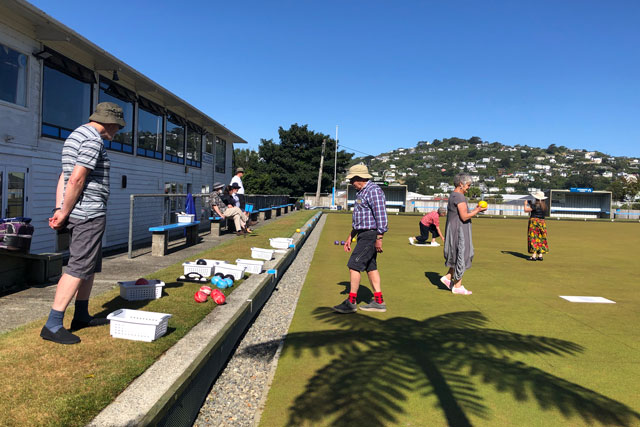
Quite a few of us were just as happy to stay inside chatting. It was a really nice opportunity to have those extended conversations not possible on the dance floor, and to get to know some of our newer dancers in particular.
Dancing
Fortified by nibbles and a drink from the bar, bowlers and chatters alike were ready to ceilidh. Rod got us moving with the Boston Two Step, an easy old time dance from the early 1900s – made progressive, so we changed partners instead of having to deal with the dreaded waltz!
From there Rod took us back in time to three dances from the seventeenth and eighteenth centuries.
First, he taught us the very old English country dance Upon a Summer’s Day, which we danced twice through (for best results). It is the first dance in the very famous ‘first’ book of country dances The Compleat Dancing Master from 1651, and is danced to the beautiful music of English folk song The Lark in the Morning.
Then a Scottish Country dance The Infare, celebrating the homecoming of a bride, danced to the song tune for Will Ye go and Marry Ketty collected by Robbie Burns. Only 16 bars of Strathspey to remember, but it kept us on our toes and those cross-handed turns were a bit of a challenge and a lot of fun.
That was followed by another very old dance the Morpeth Rant, published in A Companion to the Ballroom by Thomas Wilson. And finally, a modern dance to finish – Burns Night.
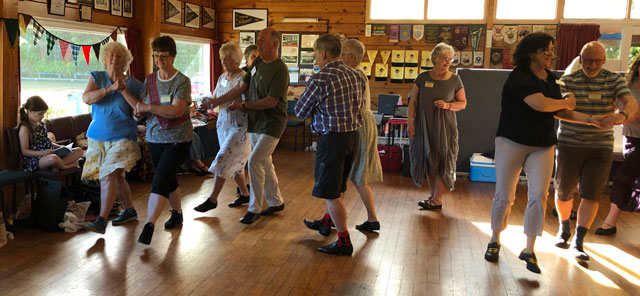
Our summer ceilidh is always held close to Burns Night, and at two previous summer ceilidhs Rod has run a full programme of dances with connections to Robbie Burns. This year was more of a mixed bag, but we still acknowledged the immense influence of Scotland’s famous poet, dancing Burns Night, and also The Infare with one of Burns’ collected song tunes.
Past Robbie Burns themed programmes took place at the club’s 2018 Summer Ceilidh, then again at the 2021 Summer Ceilidh, when Aileen Logie delivered a dramatic Address to a Haggis.
Ceilidh entertainments
Our Summer Ceilidh is made special by those members who share their talents to entertain us between dances. Each year without fail, we experience the wonderful live performances they offer, and the talents they bring.
This year, Malcolm and Deborah Shuker shared the first ceilidh slot.
It was a delight to once again enjoy Malcolm’s solo pieces on keyboard. Malcolm has performed at almost every summer ceilidh since the inaugural ceilidh at Kristin and Rod’s place in 2014. This year he played Country Tune, by Kiwi composer Christopher Norton, and Waltz in Eb by Ludwig van Beethoven, the theme of which is from a Ländler, a traditional country dance which influenced the evolution of the Viennese waltz.
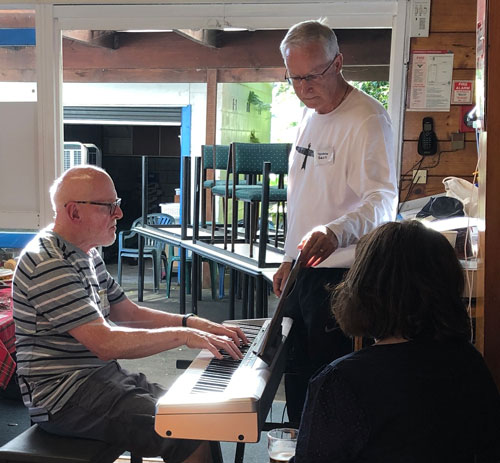
Then it was on to Deborah – a very welcome last-minute volunteer, adding to the Robbie Burns theme as she recited Burns’ poem The De’ils awa wi’ the Exciseman, from an early 1900 ‘Family Song Book’. Burns served as an exciseman, and the poem reflects the common dislike of excise officers, everyone dancing as the devil takes him away. There is also a dance by that name.
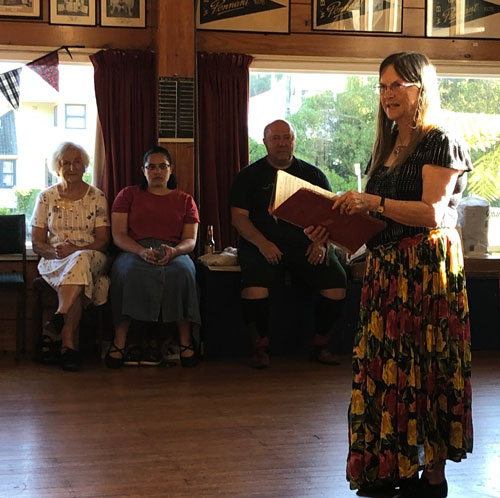
Maggie was next on the list, bringing us her animated reading of ‘The Gruffalo’, translated into Scots by James Robertson. Many of us will have read the English version, written by Julia Donaldson, but the Scots version adds its own humour, and Maggie brought all that fun to the fore.
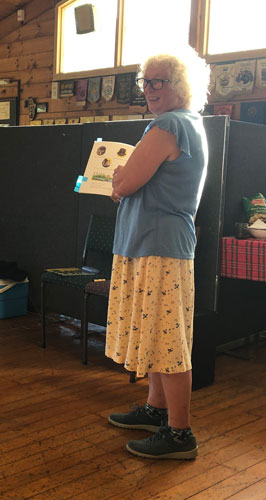
Our final ceilidh performer was Kate, who has shared her voice and her passion for song with us at many ceilidhs past. Accompanied by Malcolm, Kate sang I’ll Walk Beside You, a song published in 1936. Words by Edward Lockton and music by Alan Murray. Kate kindly dedicated her song to Rod and Kristin for their support for the club, and each other.
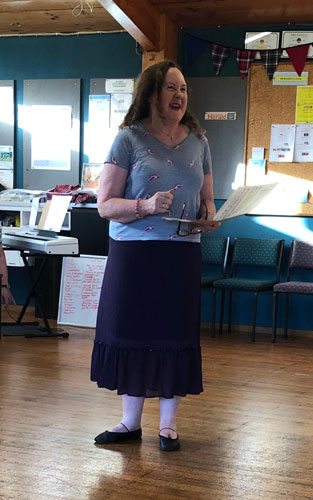
By then, Elizabeth N and the supper team had been holding dinner ready downstairs for a while, so no time for more dancing, off we went.
Potluck dinner to finish
Club members outdid themselves this year, preparing a wonderful spread of delicious food for our potluck dinner. There was something for everyone, and more than anyone could have needed or wanted amongst the mains, salads, sides and desserts.
We all relaxed, conversation flourished, food was devoured, and then it was time to clear up, pack up, and head home.
Thanks to all
First to Rod, for whom it was a busman’s holiday since he was on duty as MC. He prepared a great selection of different dances for us, got us through them all, and made sure we had a good time.
Next to the organising team of Maureen, Christine and Kristin, plus Elizabeth N and Sarah. Maureen did a fantastic job of organising the potluck dinner offerings, with Kristin on comms, Christine in support and Elizabeth on duty in the kitchen, pretty much from go to whoa. New committee member Sarah, took on the IT side of things, adapting the registration form for 2024.
Very special thanks to Deborah, Kate, Maggie and Malcolm for entertaining us with their skills and talents.
Finally, thanks to everyone who attended and brought fantastic food, volunteered for setup, kitchen duties, or pack-up, and made it such a relaxed and convivial affair. Roll on next year.
View more photos of the day by Kristin here

Kristin Downey
5 February 2024
Deborah Shuker: Dancing to exercise the body and the mind
Written by Rowena Fry
Wellingtonian Deborah Shuker has been a Scottish Country Dancer for 13 years. Known as a ‘team sport’, the centuries-old dance form is widely spread around the country with close to 90 clubs, starting at Kerikeri and finishing at Invercargill.
Twenty-six years ago, Deborah was diagnosed with type 2 diabetes. Eleven years later she had a heart attack, and it was then that she knew she needed to find a fun way to exercise regularly.
Deborah didn’t want to join a gym as she saw that as a solo endeavour and knew she wouldn’t stick to it. She tried ballroom too but found it wasn’t her cup of tea either.
A newspaper ad for a beginner’s course in Scottish Country Dancing at the Johnsonville Scottish Country Dance Club did catch her eye and in next to no time Deborah was a regular.
‘It’s perfect for me. It’s promoted as fun, fitness, and friendly, and it is all of that. It exercises your body and exercises your mind. And you don’t have to come with a partner. And it’s ridiculously cheap!’
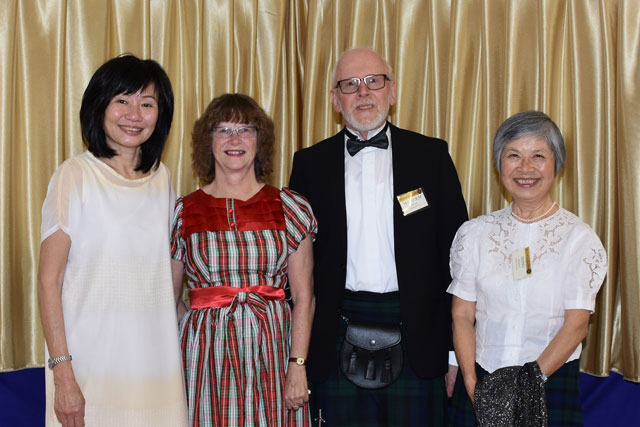
Scottish Country Dancing is a fun, social activity, usually done in groups of eight. A tutor gives out instructions at the beginning, the music starts, and you all follow the sequences which inevitably become easier as you gain experience. There are different levels of difficulty, and you can choose to join in or sit out and watch.
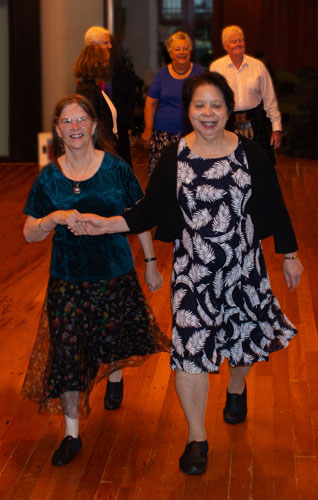
At the club’s Annual Dance, Deborah says there are always a couple of dances for the most experienced. That is when she enjoys sitting back and watching the mastery. ‘They’re beautiful to watch and live music gives a great atmosphere.’
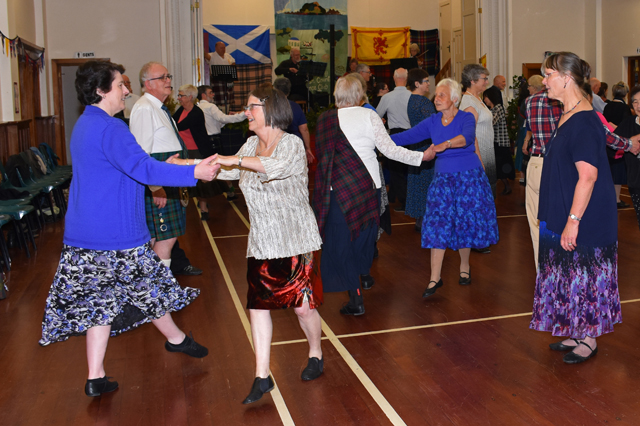
Deborah dancing the strathspey Midsummer Common at the Johnsonville 2019 Annual Dance
To an outsider it looks like a very bouncy dance and there might be concern about one’s joints. Deborah says it is bouncy but there are all ages (the eldest is in their 80s) coming to the classes, dances, and balls.
Neither injury nor age need be a barrier. ‘I can bounce, but I can’t always get to the right places. Other people get to the right places, but they can’t bounce.’

Deborah loves the social aspect of Scottish Country Dancing. There is a regular newsletter that keeps everyone in touch with each other and with nine clubs just in the Wellington area alone, you could choose to dance most nights of the week.

How has dance helped Deborah’s diabetes? ‘It’s exercise and there’s no reason to stop doing it. I think you could always do Scottish Country Dancing to some degree or another. It accommodates your body.’

It’s also good for your mental health due to both the community and the way your memory is exercised.
‘In some pieces there are 48 bars of music, and you have to remember what you’re meant to be doing in those 48 bars. You need to remember where you’re dancing, where you need to be, who you’re dancing with, and what’s going to happen next. It’s a lot of memory stuff but it’s not necessarily Einstein material.’
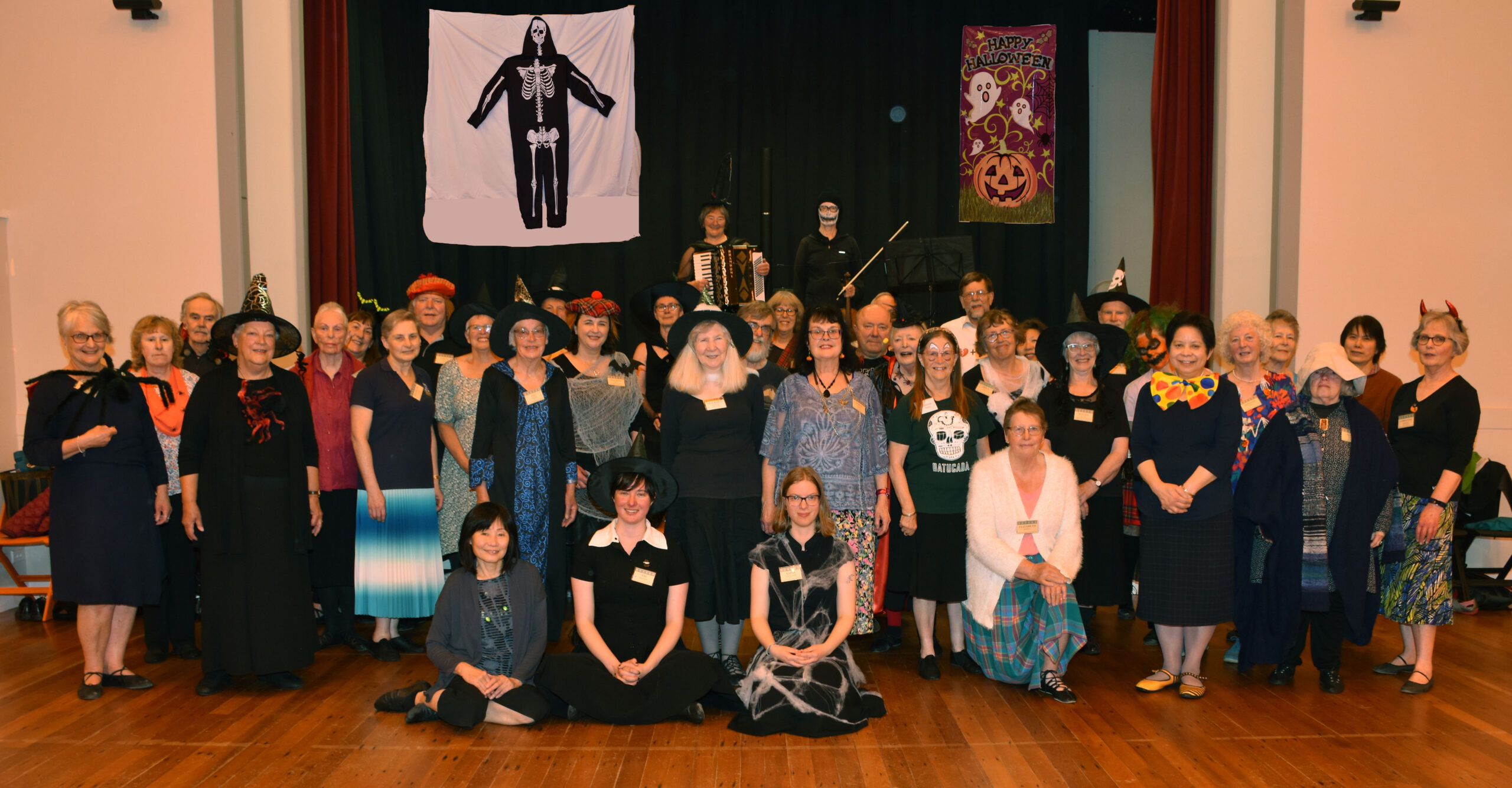
Scottish Country dancers are part of a wide-ranging community—from dancers in clubs like Johnsonville to regions across New Zealand to around the world. Wherever we go, we are welcome!
This article was written by Rowena Fry about the benefits of dance for those with (and without) diabetes and how the social activity of Scottish Country Dancing can help both physical and mental health.
Photos: Loralee Hyde
Beginners’ Classes
Join us at dancing in 2024
Scottish Country Dancing is a fun way to get fit and make new friends – all with toe-tapping Celtic music!
We welcome you to our Beginners’ Classes on 12, 19 & 26 February, 7.30pm-9.30pm on Monday nights at Khandallah Town Hall, 11 Ganges Road, Khandallah, Wellington.
Our classes suit all ages from teenagers and upwards. You can get up to 5,000 steps of your daily target for steps in a night of dancing!
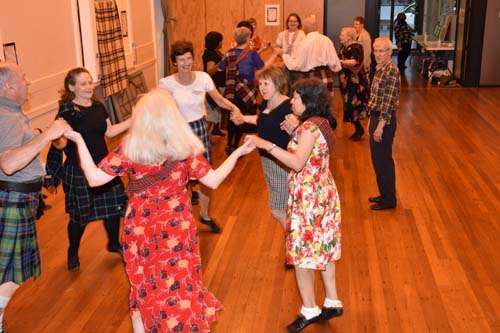
First Class: Monday, 12 February
Doors open at 7.15pm. Come along then on the first night to register and be ready to dance at 7.30pm. Pay by cash at the door.
Our tutor Rod Downey will introduce the steps over the three weeks and you’ll be up and dancing during the first evening.
- This is social dancing and we all dance together and help each other
- No partner is needed – come by yourself or with a friend
- Wear soft shoes and light comfortable clothing
- Just $5 for each class – pay by cash at the door
FREE for 2023 Johnsonville Scottish Country Dance Club members
Queries
To find out more, contact Robert on 021 163 9649 or email him or Rod/Kristin on 04 478 4948 or email them
Location
Khandallah Town Hall, 11 Ganges Road, Khandallah, Wellington.
Deborah Shuker: Dancing to exercise the body and the mind
Deborah Shuker has been a Scottish Country Dancer for 13 years. Twenty-six years ago, she was diagnosed with type 2 diabetes. Eleven years later she had a heart attack, and it was then that she knew she needed to find a fun way to exercise regularly.
A newspaper ad for a Beginners’ class in Scottish Country Dancing at the Johnsonville Scottish Country Dance Club caught Deborah’s eye and in next to no time she was a regular.
‘It’s perfect for me. It’s promoted as fun, fitness, and friendly, and it is all of that. It exercises your body and exercises your mind. And you don’t have to come with a partner. And it’s ridiculously cheap!’

Above, Deborah in the red and white dress dances Lonely Sunday at the 2016 Wellington Region New Dancers’ Celebration, an annual event held in October each year to welcome new dancers into the Scottish Country Dancing community. Longer standing dancers from across the RSCDS Wellington region attend to support their new members at this special occasion, with live music.
Isabelle and Maggie: New dancers in 2020
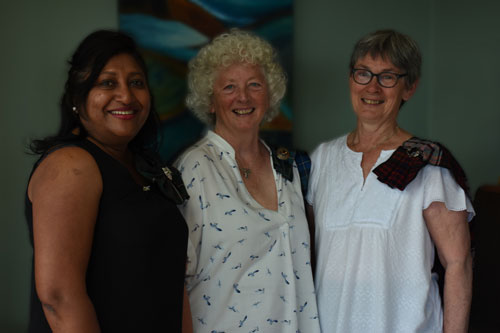
Two new dancers have kindly shared their experiences of being a new dancer at Johnsonville Club in 2020.
Find out more from Isabelle and Maggie about their first year of dancing
Poster
Download the Johnsonville Beginners’ Classes 2024 poster
Click here for more about our club and Scottish Country Dancing
Photos: Loralee Hyde
2023 Christmas Lunch: A good time in good company
Our Christmas lunch gathering is a lovely, relaxing way to end the club year. As someone remarked, Rod keeps us firmly on track on Monday nights, meaning there’s no time between dances for extended chit-chat! So it’s great to have the opportunity to slow down, sit around, and talk to each other.
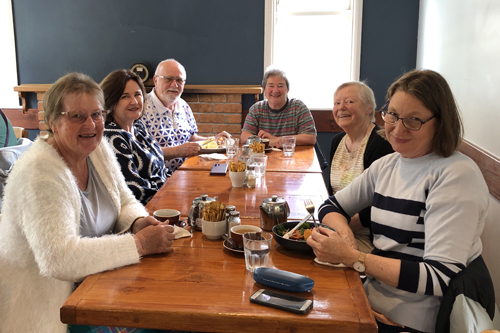
More than 25 people came along this year, including a few workers who’d managed to arrange their work commitments to enable them to attend, plus club musician Aileen Logie. This is the largest turnout ever, and as tables freed up, we took over the whole front room—in the nicest possible way.

A lot of coffee was drunk and food consumed, accompanied by lively conversation and laughter. Jackie and the team at Café Thyme looked after us wonderfully well, and many of us stayed long enough for a second round of coffee, or just one more little snack …
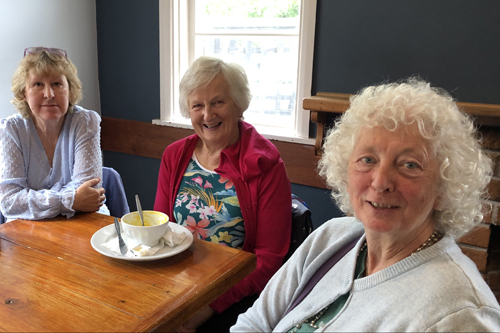
Relative to all the club’s other events, the club Christmas lunch is an organiser’s dream. Having selected the date, the invite goes out, you make a list, give numbers to the venue, everyone comes full of Christmas spirit and we all have a good time.
There are no decorations, no dance programme or music to organise, no food to order, no money to collect or pay out from the club. And everyone comes when it suits them, and leaves when they need to.
The only thing resembling ‘hall setup’ is arriving early to secure tables. Café Thyme knows we’re coming but doesn’t take bookings, so a few dedicated souls turn up early to claim our tables as other patrons leave. We try not to drive other café-goers away, though we did get a polite request this year to settle in to our seats rather than ‘hovering’ quite so obviously.

Many thanks to Maura Beattie who took over this year’s Christmas lunch organisation, I found it tremendously freeing not to have to worry about anything other than what I would drink and eat (and drink and eat again later).

It was wonderful to spend time in such good company, and it was a very nice surprise to be presented with a card and gluten free food voucher from the club, thanking me for my work over the year as Club President.
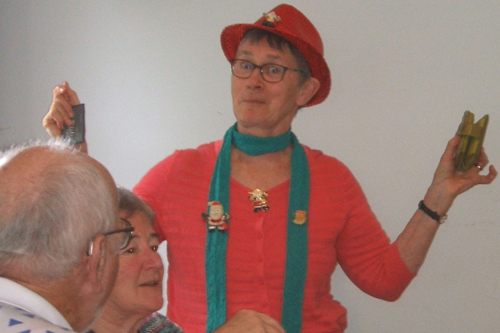
Time for a summer break, then on with a new year of club dancing.

Kristin Downey
20 December 2023
All photos by Kristin Downey except where noted




